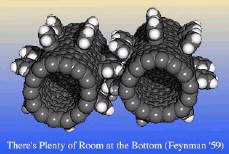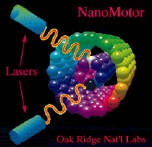|
Breakthroughs
|
|
Here are some breakthroughs that we need to
make our invention become a reality. |
|
Carlo Montemagno of UCLA's nano systems is developing
small sensors that locomote themselves to where you want them to go. This is the technology that Nano Snippit-Bots will rely on to navigate its way through the blood vessels in the brain and to find the brain tumor. |
|
We need billions of dollars (venture capital) to develop
molecular manufacturing because the benefits for medicine, the economy, and the environment are potentially great. |
|
|
|
To date, researchers have combined
organic molecules and similarly small pieces of metal to produce tiny motors capable of moving things dozens of times larger than the device itself (like an ant!). The motor's key components are found in a combination of molecules that synthesize ATP, a chemical used as an energy source in all living things. These motors will need to be refined and built upon to create our invention. |
|
At UCLA, a team is studying biological electrical functions
such as ion-channel switching and the nanocircuitry of biological systems, hoping one day to chemically synthesize a computer. Our invention will require this capability so it would be able to communicate with the doctor and navigate its way through the blood vessels in the brain. |
|
How will our Nano Snippit-Bot be manufactured? There
are three possible ways that are presently being explored. One way is in the form of top-down procedures, such as moving molecules around with tiny robotic "hands". We could use a bottom-up process, such as replicating cells. The other way is to create self assembling mechanical systems- objects that copy themselves. |
|
Chemical interactions make the motors move. In order to
harness this motion, it involves attaching a rotor to the shaft. Using techniques involved in manufacturing computer chips, Montemagno created nickel rotors about 700 nanometers long and found the rotors and motors came together on their own. Such an engine is useful, but not if it is always in motion. Adding zinc to a solution containing the motors will shut them down, and flushing the zinc out starts them again. The researchers discovered individual zinc atoms will attach to certain points between the motors' cylinders, preventing them from flexing. These motors would need to be refined and built upon to create our invention. |


|
Electrocauterization uses an electrical current through a
small probe to cauterize, or seal, blood vessels. The Nano Snippit-Bot would use electrocauterization through its gold claws to seal the blood vessels as they are being snipped. Gold is a good conductor of electricity, so this is possible. |

|
This is a NanoGear.
|
|
NanoGears
|
|
NanoMotor
|
|
N.R.
|
|
First, we must educate the public about nanotechnology and
our invention. Then, we need to work with the motors in the real-world environment. Once this is done, the NSBs could navigate through the body. Finally, we would need to move the NSBs to clinical applications. |